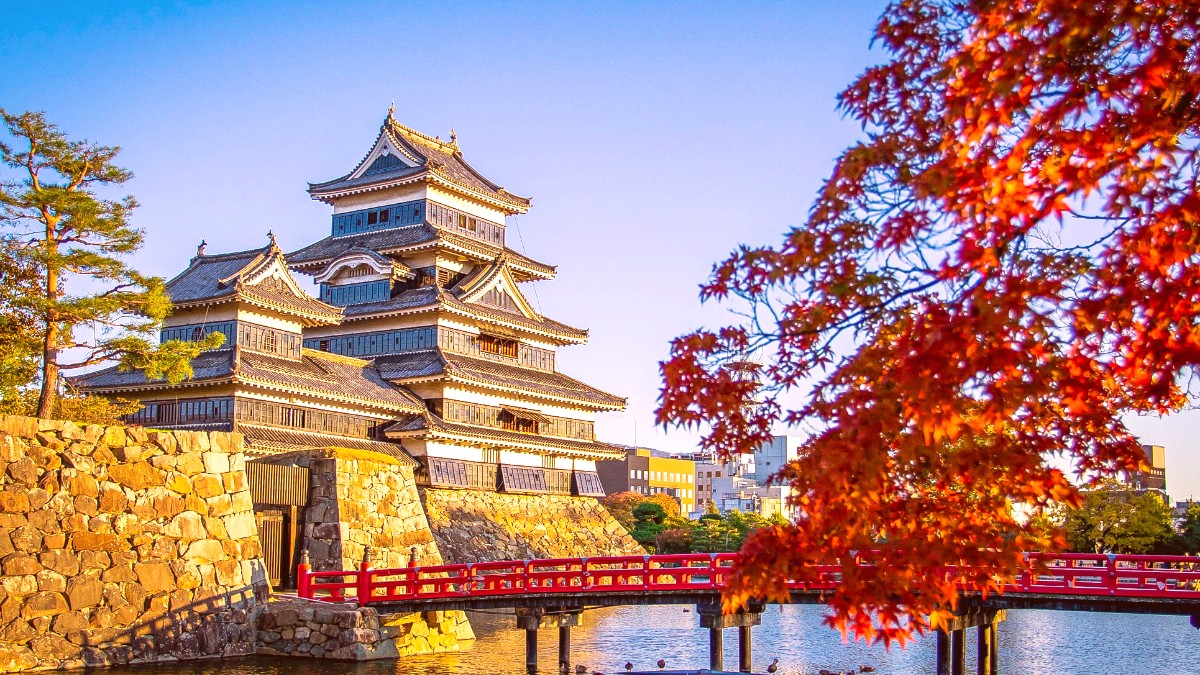
Central Honshu, Japan
Imagine standing before a castle with walls the color of midnight, its reflection mirroring perfectly in a still moat, framed by towering peaks. This is Matsumoto Castle, a captivating sight that draws visitors to the city it has guarded for centuries. Beyond this impressive landmark, Matsumoto unfolds as a place where the echoes of history harmonize with the crisp air of the mountains. It is a destination for those who appreciate authentic culture, serene beauty, and the promise of mountain adventure.
Matsumoto boasts a deep history, with its origins firmly rooted in the feudal era. The city's story began around 1504, when the first fortifications, then known as Fukashi Castle, appeared. These defenses grew in importance, eventually transforming into the formidable Matsumoto Castle during the Edo period (1603-1868).
The Meiji Restoration in 1868 brought changes to Japan, and Matsumoto embraced modernization. It became a forward-thinking hub for education and the arts. A distinguished achievement during this period was the establishment of Kaichi Gakko main School in 1873. Its striking Western-style architecture, completed in 1876, made it one of Japan’s earliest modern schools and a symbol of the nation's rapid adoption of new ideas.
Matsumoto is a city of distinctive character, celebrated above all for its iconic black-and-white Matsumoto Castle. A designated National Treasure, this castle ranks among Japan's best-preserved original castles, presenting a rare opportunity to step inside a feudal stronghold that has lasted for centuries. Its striking architecture, with its dark timber and white plaster, creates a powerful visual impression, especially when reflected in its surrounding moat. The castle is a living monument that embodies the city's historical soul.
The city features several museums that cater to varied interests. The Matsumoto City Museum of Art attracts international attention with its permanent exhibition dedicated to the avant-garde artist Yayoi Kusama, a local native. Her whimsical, polka-dotted works offer a stark, yet engaging, contrast to the city's traditional aesthetic. Traditional streets like Nakamachi-dori, lined with historic white-walled storehouses now housing artisan shops and cafes, and Nawate-dori, a charming pedestrian lane known for its frog-themed souvenirs and local snacks, create delightful areas for leisurely strolls and unique shopping.
A pristine alpine valley often called 'Japan's Yosemite,' known for its breathtaking scenery and hiking trails.
Another nearby highland area, Norikura Kogen, presents additional opportunities for outdoor activities, from high-altitude trekking in summer to skiing in winter.
Matsumoto acts as a natural hub, making it a starting point for exploring the wider Chubu Sangaku National Park, which encompasses much of the Northern Alps.
The surrounding mountains influence the city's cooler, less humid summers and its snowy winters, making each season unique.
This dual appeal—a well-preserved historical core combined with access to spectacular natural landscapes—makes Matsumoto a captivating destination.
This commitment to education continued through the 20th century. Matsumoto also gained recognition as the birthplace of the Suzuki Method of music education, a globally recognized approach founded by Shinichi Suzuki. His work in early childhood music education has influenced countless students worldwide, further cementing Matsumoto’s legacy as a place of innovation and cultural development.
Under the rule of various daimyo (feudal lords) of the Matsumoto Domain, the castle became the administrative and cultural heart of the region. Matsumoto flourished as a castle town, its streets laid out to serve the castle and its inhabitants. Merchants thrived in areas like Nakamachi, their distinctive white-walled storehouses (kura) still visible today, speaking to a time of bustling commerce. The city's structure, with its grid pattern radiating from the castle, reflects this historical development.
A distinguished achievement during this period was the establishment of Kaichi Gakko main School in 1873. Its striking Western-style architecture, completed in 1876, made it one of Japan’s earliest modern schools and a symbol of the nation's rapid adoption of new ideas.
Matsumoto offers an unique blend of historical richness and natural splendor, serving as a gateway to the majestic Japanese Alps. It is a destination where ancient samurai history meets breathtaking mountain landscapes.
Matsumoto's identity as a place of historical charm and natural beauty is further cemented by its role as a practical base for exploring the surrounding Japanese Alps. Travelers use Matsumoto as their starting point for adventures into destinations like Kamikochi, a pristine alpine valley often called 'Japan's Yosemite,' known for its breathtaking scenery and hiking trails.
Norikura Kogen, another nearby highland area, presents additional opportunities for outdoor activities, from high-altitude trekking in summer to skiing in winter. This dual appeal—a well-preserved historical core combined with access to some of Japan's most spectacular natural landscapes—makes Matsumoto a captivating and rewarding destination for any traveler.
Discover the iconic Matsumoto Castle and its feudal heritage, walking through centuries of history.
Explore museums like Matsumoto City Museum of Art, featuring local artist Yayoi Kusama, and stroll traditional streets.
Use Matsumoto as a base for excursions into the Japanese Alps, including Kamikochi and Norikura Kogen, for hiking and skiing.
Matsumoto flourishes as a castle town, its streets laid out to serve the castle and its inhabitants. Nakamachi-dori, lined with distinctive white-walled storehouses (kura), speaks to a time of bustling commerce. Nawate-dori charms with its frog-themed souvenirs and local snacks.
Matsumoto Castle stands for over 500 years, offering a journey through Japan's feudal past.
A landmark of modern education, symbolizing Japan's forward-thinking embrace of new ideas.
Cherry blossoms typically bloom in mid-April, transforming the city.
Late October to mid-November for breathtaking autumn foliage in the Alps.
Snowfall from December to February creates a picturesque snowy landscape, perfect for skiing.